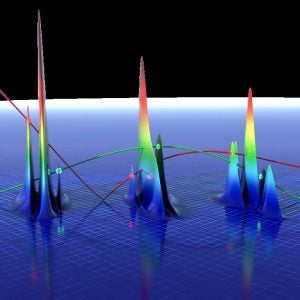 Light can be used to excite matter, which then evolves with its natural frequency much like the sound made by an organ pipe. Deterministic excitation of matter, known as coherent control, has applications ranging from quantum computing and simulation to controlling chemical reactions. These applications will benefit significantly from coherent control of large ensembles of particles/oscillators. However, much like the different sounds made by organ pipes of different lengths, in general, distinct particles have different natural frequencies, which is referred to as the inhomogeneous broadening. Inhomogeneous broadening masks the effect of coherent control on an ensemble. This effect is especially significant in semiconductor quantum dots, which are equivalent to artificial atoms, due to a spread in their sizes introduced during the manufacturing process. Just as for organ pipes, a quantum dot’s natural frequency depends on its size. Studying single dots is one approach to avoid this limitation. In this work, we measure the effect of coherent excitation of ten million quantum dots with ultrafast pulses using pre-pulse two-dimensional coherent spectroscopy. This work has general applicability to other systems such as molecules in solution and atomic vapors, where inhomogeneity might obscure the effect of coherent control.
Light can be used to excite matter, which then evolves with its natural frequency much like the sound made by an organ pipe. Deterministic excitation of matter, known as coherent control, has applications ranging from quantum computing and simulation to controlling chemical reactions. These applications will benefit significantly from coherent control of large ensembles of particles/oscillators. However, much like the different sounds made by organ pipes of different lengths, in general, distinct particles have different natural frequencies, which is referred to as the inhomogeneous broadening. Inhomogeneous broadening masks the effect of coherent control on an ensemble. This effect is especially significant in semiconductor quantum dots, which are equivalent to artificial atoms, due to a spread in their sizes introduced during the manufacturing process. Just as for organ pipes, a quantum dot’s natural frequency depends on its size. Studying single dots is one approach to avoid this limitation. In this work, we measure the effect of coherent excitation of ten million quantum dots with ultrafast pulses using pre-pulse two-dimensional coherent spectroscopy. This work has general applicability to other systems such as molecules in solution and atomic vapors, where inhomogeneity might obscure the effect of coherent control.
This work was published in Physical Review Letters on Oct. 6, 2016 and selected as an “Editors Suggestion”. It is also the subject of a highlight on physics.aps.org.
Related Links: article


